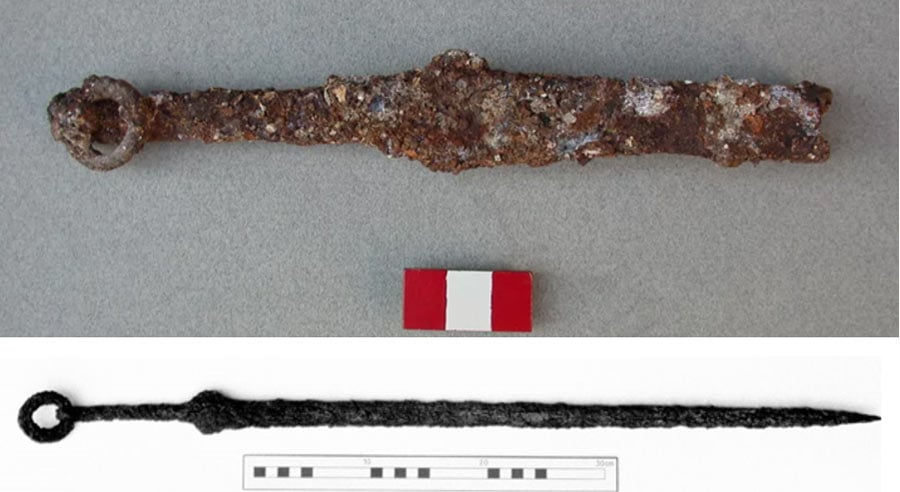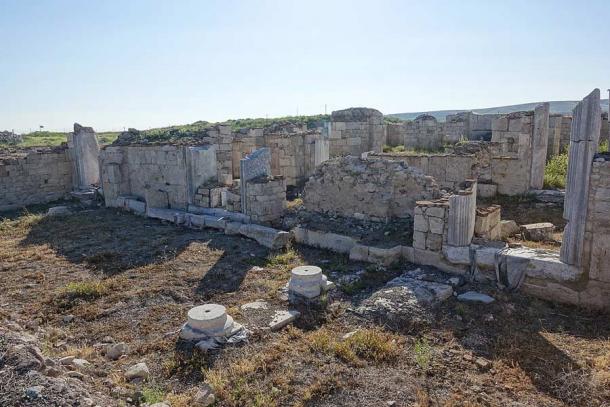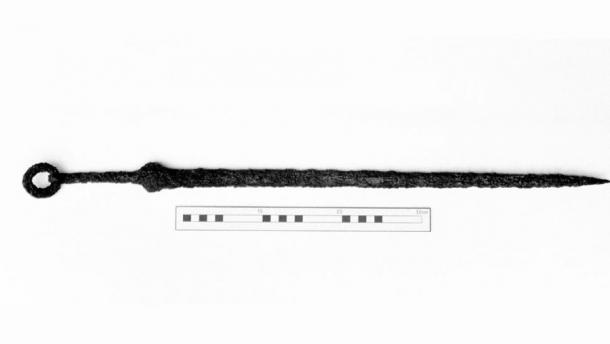In classical antiquity, Amorium was an important, strategically located city in the kingdom of Phrygia in the west central part of Anatolia, in what is now Asian Turkey. Amorium was founded in the Hellenistic period (323 BC – 31 BC) and flourished in the Byzantine period (5th century AD – 15th century AD) until it was sacked by certain Arabs in 838 AD. However, the city remained important well into the 11th century.

Now, archaeologists have discovered two ‘rare and unique’ swords from this once heavily fortified city, including one from underneath a church, perhaps indicating an offering, reports Verve Times .
These swords are known as ring pommel swords, but just how rare these examples are has only now been revealed by a study titled “ Ring Pommeled Swords From Amorium ,” published in December 2021, in The Journal of Art History .
Uncovering Amorium
Amorium has been the site of archaeological excavations since 1988, and these two iron, ring pommeled swords (where ring pommeled refers to a rounded knob at the end of the sword’s handle shaped like a ring) were found at the site.
The first sword was found in the atrium of a church in 1993, completely fragmented and corroded. The second was discovered in 2001 in the lower part of the city. Both these finds have been dated to the 10th-11th centuries AD, also known as the middle Byzantine period (843-1204 AD).
What is so unique about these finds is not just the ring pommel handles, which were a rarity in the Byzantine period, but also the inscriptions on them. Intriguing features on the swords distinguish “them from the ring pommeled swords of the nearby civilizations,” the researchers wrote in the study, as quoted in Live Science .
Most Byzantine swords are of the paramerion type, which is a saber-like curved sword, and heavily favored by the Byzantine military. Preliminary examinations did not reveal anything to researchers in terms of which clan, empire, or mercenary group used these unique Byzantine pommeled swords unearthed at Amorium.

View of excavated buildings in the lower town of Amorium, which was inhabited until the 12th century.
Amorium: A Great City Sacked By the Arabs and Seljuks!
Amorium functioned as a vital link between the Byzantine capital of Constantinople, Nicaea (northwest Anatolia), and Ancyra (present-day Ankara), which made it a key first line of defense against the Arabs. The ancient city was an important military and trade stronghold for the Byzantines because of its strategic position. But after two tries, beginning with the Umayyad Caliphate’s 646 AD assault, the Arabs managed to more or less destroy the city in 838 AD.
In the middle of the 8th century, Amorium reached its zenith under Constantine V and his successor, Michael II, who established an Amorian dynasty, with Amorium as the designated capital. It had, by now, become the biggest and most prosperous city in Asia Minor, which was also why it had a target on its back. The city was finally captured and burned to the ground in 838 by a son of Caliph Harun al-Rashid.

Amorium was rebuilt after the Arab sacking but burned again in the 10th century AD. Despite the Arab attacks, the city continued to function as an important center until well into the 11th century. till the Seljuks razed it to the ground in the 1070s AD. After the Seljuk destruction the city never recovered.
Amorium was rediscovered by Irish clergyman Richard Pococke in 1739, who was renowned for his travel writing. English geologist William Hamilton took an interest in the site in 1836, and from this period onwards, it was a known ruin site but not much else.
It was only in 1989 excavations at the Amorium ruins finally began, sponsored by the British Institute of Archaeology at Ankara, and various institutions in the US. Fieldwork restarted in 2014 under the aegis of Dr. Zeliha Demirel Gökalp of Anadolu University, who is the lead author of the current study.

The ring pommeled sword discovered in the lower part of Amorium, a major city in the Byzantine Empire.
Analyzing the Two Amorium Pommel-Ringed Byzantine Swords
Study lead researcher Errikos Maniotis, an independent researcher from Aristotle University of Thessaloniki, Greece, said that the sword discovered first (in 1993) can be considered “bizarre” even though it was customary to lay down weapons in holy places. “It is known from the [historic] sources that weapons have been deposited as votive offerings in churches,” Maniotis told Live Science via email.
Weapons placed in churches are “usually associated with holy relics connected with the warrior saints,” he added. “Moreover, we have the deposit of armament in Mount Athos monasteries , such as a chainmail shirt that is stored in Iveron Monastery. So, this sword could have a votive character, offered by its owner to the church along with other objects, perhaps.”
To add to the unique structure of the church sword, is the fact that it has a cross guard, a piece of metal sitting perpendicular to the blade at the end of the handle.
The second sword has a 14-centimeter (5.5-inch) long handle, and a 61 centimeter (24 inch) blade, possibly used by a Byzantine soldier as a secondary sword during battle, as an emergency or optional blade.
In fact, so unique is the nature of these finds that researchers are proposing giving their designs a new name: “hybrid Byzantine ring pommeled swords .” While ring pommeled swords have been found in other notable historical cultures, especially the Chinese Han Dynasty which likely influenced nomadic Scythian and Huns to imitate the Chinese version of a ring pommeled sword. Sarmatian mercenaries and Roman military leaders learned about these swords from the Scythians and Huns.

The hybrid Byzantine ring pommeled swords, found near each other, point to the possibility of an armory in the area of Amorium that produced this type of sword handle, according to the researchers. The lack of corroborative evidence suggests that the discovery of these swords at the Amorium site could be nothing more than coincidence. Moving forward, more research and analysis of this “new” sword type will likely tell us more about them.





